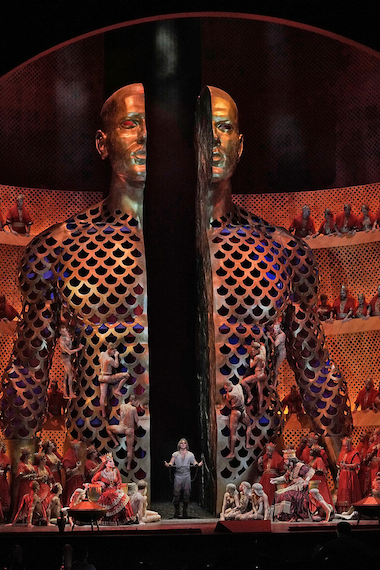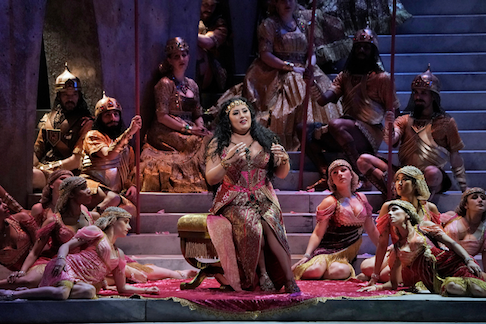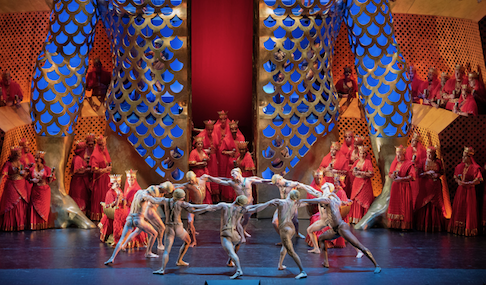
27 Mar 2019
Samson et Dalila at the Met
It was the final performance of the premiere season of Darko Tresnjak’s production of Camille Saint-Saëns' Samson et Dalila. Four tenors later.
English Touring Opera are delighted to announce a season of lyric monodramas to tour nationally from October to December. The season features music for solo singer and piano by Argento, Britten, Tippett and Shostakovich with a bold and inventive approach to making opera during social distancing.
This tenth of ten Live from London concerts was in fact a recorded live performance from California. It was no less enjoyable for that, and it was also uplifting to learn that this wasn’t in fact the ‘last’ LfL event that we will be able to enjoy, courtesy of VOCES8 and their fellow vocal ensembles (more below …).
Ever since Wigmore Hall announced their superb series of autumn concerts, all streamed live and available free of charge, I’d been looking forward to this song recital by Ian Bostridge and Imogen Cooper.
The Sixteen continues its exploration of Henry Purcell’s Welcome Songs for Charles II. As with Robert King’s pioneering Purcell series begun over thirty years ago for Hyperion, Harry Christophers is recording two Welcome Songs per disc.
Although Stile Antico’s programme article for their Live from London recital introduced their selection from the many treasures of the English Renaissance in the context of the theological debates and upheavals of the Tudor and Elizabethan years, their performance was more evocative of private chamber music than of public liturgy.
In February this year, Albanian soprano Ermonela Jaho made a highly lauded debut recital at Wigmore Hall - a concert which both celebrated Opera Rara’s 50th anniversary and honoured the career of the Italian soprano Rosina Storchio (1872-1945), the star of verismo who created the title roles in Leoncavallo’s La bohème and Zazà, Mascagni’s Lodoletta and Puccini’s Madama Butterfly.
Evidently, face masks don’t stifle appreciative “Bravo!”s. And, reducing audience numbers doesn’t lower the volume of such acclamations. For, the audience at Wigmore Hall gave soprano Elizabeth Llewellyn and pianist Simon Lepper a greatly deserved warm reception and hearty response following this lunchtime recital of late-Romantic song.
Collapsology. Or, perhaps we should use the French word ‘Collapsologie’ because this is a transdisciplinary idea pretty much advocated by a series of French theorists - and apparently, mostly French theorists. It in essence focuses on the imminent collapse of modern society and all its layers - a series of escalating crises on a global scale: environmental, economic, geopolitical, governmental; the list is extensive.
For this week’s Live from London vocal recital we moved from the home of VOCES8, St Anne and St Agnes in the City of London, to Kings Place, where The Sixteen - who have been associate artists at the venue for some time - presented a programme of music and words bound together by the theme of ‘reflection’.
'Such is your divine Disposation that both you excellently understand, and royally entertaine the Exercise of Musicke.’
Amongst an avalanche of new Mahler recordings appearing at the moment (Das Lied von der Erde seems to be the most favoured, with three) this 1991 Mahler Second from the 2nd Kassel MahlerFest is one of the more interesting releases.
‘And there was war in heaven: Michael and his angels fought against the dragon; and the dragon fought and his angels, And prevailed not; neither was their place found any more in heaven … that old serpent … Satan, which deceiveth the whole world: he was cast out into the earth, and his angels were cast out with him.’
If there is one myth, it seems believed by some people today, that probably needs shattering it is that post-war recordings or performances of Wagner operas were always of exceptional quality. This 1949 Hamburg Tristan und Isolde is one of those recordings - though quite who is to blame for its many problems takes quite some unearthing.
There was never any doubt that the fifth of the twelve Met Stars Live in Concert broadcasts was going to be a palpably intense and vivid event, as well as a musically stunning and theatrically enervating experience.
‘Love’ was the theme for this Live from London performance by Apollo5. Given the complexity and diversity of that human emotion, and Apollo5’s reputation for versatility and diverse repertoire, ranging from Renaissance choral music to jazz, from contemporary classical works to popular song, it was no surprise that their programme spanned 500 years and several musical styles.
The Academy of St Martin in the Fields have titled their autumn series of eight concerts - which are taking place at 5pm and 7.30pm on two Saturdays each month at their home venue in Trafalgar Square, and being filmed for streaming the following Thursday - ‘re:connect’.
The London Symphony Orchestra opened their Autumn 2020 season with a homage to Oliver Knussen, who died at the age of 66 in July 2018. The programme traced a national musical lineage through the twentieth century, from Britten to Knussen, on to Mark-Anthony Turnage, and entwining the LSO and Rattle too.
With the Live from London digital vocal festival entering the second half of the series, the festival’s host, VOCES8, returned to their home at St Annes and St Agnes in the City of London to present a sequence of ‘Choral Dances’ - vocal music inspired by dance, embracing diverse genres from the Renaissance madrigal to swing jazz.
Just a few unison string wriggles from the opening of Mozart’s overture to Le nozze di Figaro are enough to make any opera-lover perch on the edge of their seat, in excited anticipation of the drama in music to come, so there could be no other curtain-raiser for this Gala Concert at the Royal Opera House, the latest instalment from ‘their House’ to ‘our houses’.
"Before the ending of the day, creator of all things, we pray that, with your accustomed mercy, you may watch over us."

It was the final performance of the premiere season of Darko Tresnjak’s production of Camille Saint-Saëns' Samson et Dalila. Four tenors later.
Serbian born American theater director Darko Tresnjak envisioned a production with the look of a nickelodean (maybe you put your nickel in and out comes “Mon coeur s’ouvre à ta voix”). Or maybe he was thinking of a slot machine (bet with the odds that the tenor can’t make it to the end). He did like shiny, flowing pale blues and pinks for the intimate scenes within his arched scenic structure, intense reds and metallic blues for the big scenes trusting perhaps that these shapes and colors were enough to tell the story.
What the Met did do right was hire English conductor Mark Elder to expose the magnificence of the Metropolitan Opera orchestra, and to motivate the glories of the Met chorus whose opening scene reeked with overt Baroque-esque, old testament Romantic musical profundities that gave us enormous pleasure.
 Anita Rachvelishvili as Dalila
Anita Rachvelishvili as Dalila
The stifling symmetry of Broadway designer Alexander Dodge’s scenic structure placed the singers squarely center stage for their big numbers where the artists of the evening did their best to measure up to the symphonic magnificence rising from the pit. Georgian mezzo soprano Anita Rachvelishvili well held her own in powerful voice though I missed a warmth of sensual phrasing in her two famous second act arias. A well-known Carmen Mme. Rachvelishvili did find plenty of fire in her confrontations with Samson and the High Priest.
Lithuanian tenor Kristian Benedikt, who last fall was called upon to finish the opera when tenor Roberto Alagna gave up after the second act, was the Samson at this performance (his only full performance in this 2018/19 run). Mr. Benedikt did make it all the way to the end, though he encountered some rough patches in the second act. Both his first and third act arias were beautifully rendered, his fine tenor holding strong tone to their conclusions. However in the second act and the final scene of the opera his persona and voice were swallowed into the grander trappings of the staging.
The High Priest of Dagon was sung in all thirteen performances by bass-baritone Laurent Naouri in easily distinguishable French though his delivery did not rise to the musical elegance of Saint-Saëns' score and Mo. Elder’s conducting. Note also that the back-of-seat “super” titles (very hard to see) were offered in German and Spanish. Why not French, as it is, after all, the language of the opera?
 Male dancers of the corps de ballet
Male dancers of the corps de ballet
Besides the splendid second act arias the famed part of Saint-Saëns' masterwork is the third act orgy that culminates in the destruction of the pagan temple. Ten almost naked ballerinos and eight ballerinas executed a complex choreography conceived by Austin McCormick, artistic director of Brooklyn’s Company XIV. The unballetic style was Martha Graham avant gardesque, a look that flowed uneasily with the grander formal structures of the Saint-Saëns' score.
Despite the thunderous percussion climax the short circuit electric flash within Mr. Tresnjak's nickelodeon did not satisfy as Samson’s crowning moment of superhuman strength. Mr. Tresnjak’s staged oratorio setting of Saint-Saëns' score would have profited from some operatic context.
Michael Milenski
Cast and production information:
Dalila: Anita Rachvelishvili; Samson: Kristian Benedikt; Abimélech: Tomasz Konieczny; High Priest of Dagon: Laurent Naouri; First Philistine: Eduardo Valdes; Secon Philistine: Jeongcheol Cha; A Philistine Messenger: Scott Scully; An Old Hebrew: Günther Groissböck. Chorus and Orchestra of the Metropolitan Opera. Conductor: Mark Elder; Production: Darko Tresnjak; Set Designer: Alexander Dodge; Costumes Designer: Linda Cho; Lighting Designer: Donald Holder; Choreographer: Austin McCormick. Metropolitan Opera, New York, March 28, 2019.